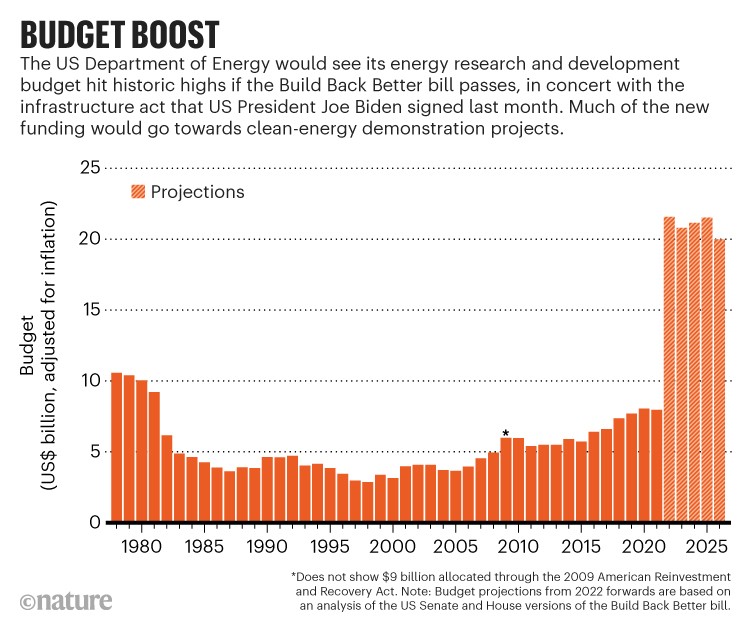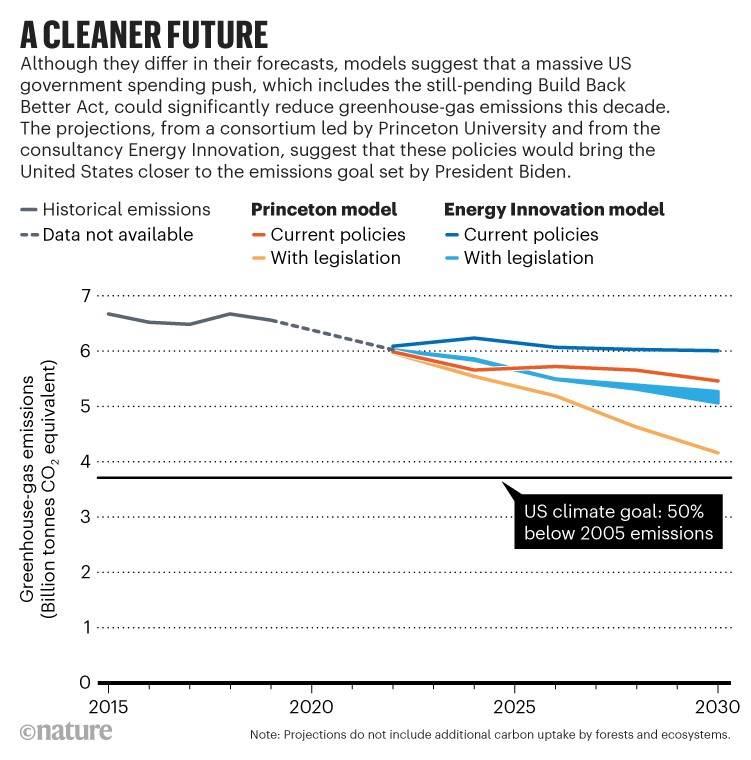US President Joe Biden and his fellow Democrats in Congress are rushing to enact a US$2-trillion budget bill that would boost US investments in technologies for fighting climate change to record levels. If it passes, and everything goes just right, some scientists say that the legislation — dubbed the ‘Build Back Better’ act — could bring the United States closer to meeting the goals that Biden laid out during a major United Nations climate summit in Glasgow, UK, last month. According to researchers interviewed by Nature, the latest economic models suggest that the massive cash infusion could drive down prices for clean-energy technologies and help put the United States on a path to reduce greenhouse gases to 50% below 2005 levels by 2030 — although they also warn that there are still plenty of potential barriers and roadblocks ahead.
“If Build Back Better passes, it basically buys us a decade of climate progress in the United States,” says Jesse Jenkins, who models energy systems at Princeton University in New Jersey and who is heading up a consortium there that has been analysing the potential impacts of the legislation. “It’s a huge deal.”
But the bill’s fate remains up in the air. Although the US House of Representatives has already passed its version, Senate Democrats are at an impasse over their draft, which could push into next year. Many Republicans supported a related trillion-dollar infrastructure bill that Biden signed into law last month, but they are steadfastly opposing the larger budget bill, which includes new investments in energy and climate technologies, as well as a variety of more controversial social programmes that are holding up negotiations. Some say the bill is too costly, and others oppose individual elements. Biden and the Democratic leadership are now trying to secure the support of all 48 Democratic senators and two independents, which would allow for passage of the legislation with a tie-breaking vote by Vice-president Kamala Harris.
Big money
Table of Contents
Build Back Better represents a strategic shift in political strategy when it comes to climate change. During former president Barack Obama’s time in office, Democrats tried to pass legislation to cap the country’s overall greenhouse-gas emissions and force companies to clean up — or compete for an ever-declining pool of carbon credits to cover their emissions. Now, however, the Biden administration is seeking to use large government investments to curb emissions by driving down the cost of low-carbon technologies, creating new industries and jobs, and bolstering US competitiveness abroad.
“This represents a much more robust role for the US government in the commercialization and scale-up of energy technologies, and it’s something that a lot of academics, analysts and scientists have been calling for quite a long time,” Jenkins says.
The new spending legislation would allocate more than $550 billion to energy and climate programmes. This includes an estimated $320 billion in tax reductions over a decade for businesses and individuals who invest in clean-energy technologies such as wind, solar, electric vehicles and nuclear power. The legislation would build on clean-energy provisions in the bipartisan infrastructure package, which includes $66 billion to modernize rail networks, $90 billion for broader public-transport investments and some $72.5 billion for clean-energy transmission, grid infrastructure and charging stations for electric vehicles.
All told, the US Department of Energy could see its budget for energy research and development more than double if Build Back Better passes — from around $8 billion to more than $20 billion annually over the next five years — according to an analysis by the Information Technology and Innovation Foundation, a think tank based in Washington DC (see ‘Budget boost’). Much of that funding, already locked in through the infrastructure act, is directed towards large-scale projects to prove the feasibility of technologies such as carbon-capture systems and clean hydrogen production.
Scientists and environmentalists say that the investments, combined with tax credits and other incentives, could help to change the energy landscape over the coming decades. And by mostly focusing on financial rewards rather than punitive regulations — which can be overturned by courts and future administrations — advocates say that the agenda could build crucial political support among businesses and industries in the years to come.
“We’re always trying to look for the durable, lasting solution,” says Lindsey Baxter Griffith, federal policy director at the Clean Air Task Force, an environmental advocacy group based in Boston, Massachusetts. “The nice thing about an innovation agenda and a government investment agenda is that if it’s done correctly, you can actually grow the political support while it’s happening.”
Model behaviour
Academics and energy experts have been running various models to determine the likely impact of the legislation, and their results suggest that the spending bill and infrastructure bill combined could reduce annual US emissions by anywhere from the equivalent of 739 million to 1.3 billion tonnes of carbon dioxide by 2030 (see ‘A cleaner future’). At the upper end, this would be enough to nearly meet Biden’s Glasgow pledge to curb US greenhouse-gas emissions by 50%, compared with 2005 emissions levels.
Modelling by Jenkins and his colleagues in the Princeton consortium suggest that the bills’ biggest impacts could be in the electricity and transport sectors, each responsible for one-third of potential emissions reductions. Electricity consumption would actually rise — partly owing to the electrification of transport, driven by tax credits for electric passenger vehicles and zero-emission commercial vehicles. But emissions would drop for electricity generation, accomplished largely through the introduction of more wind and solar technology — at three to four times the current pace — and a continued decline in coal-fired power generation.
“This is classic industrial policy,” Jenkins says. Rather than tell people what to do, he says, the government is trying to change behaviour by making clean technologies the most profitable choice.
The Build Back Better bill would also boost the subsidy for projects capturing and sequestering carbon emissions from coal and natural-gas power plants, from $50 to $85 per tonne of CO2, while providing a $180 subsidy for facilities that extract CO2 directly from the atmosphere. The Princeton model suggests that this could be enough to kick-start the carbon-capture industry, which has been floundering for more than a decade; facilities participating in the practice would account for some 12% of the 1.3 billion tonnes of emissions reductions in that model.
Although the models tend to agree on the general trends, they can vary considerably in detail. Energy Innovation, a consultancy based in San Francisco, California, projects a slower roll-out of clean electricity, electric-vehicle sales and carbon-capture technologies, significantly reducing the emissions reductions forecast by the Princeton group. “The modelling approaches are producing somewhat different results, but it’s more important to focus on the overlap: there’s a really significant amount of emissions reductions that are on the table with this legislation,” says Robbie Orvis, a senior director at Energy Innovation. And the biggest factor in any of the models, Orvis says, is the plummeting price of clean-energy technologies, which enables each dollar invested to do 10 times as much work today as it would have done a decade ago.
Reality check
The biggest challenge for modellers is representing the real world. Although the models tend to agree on the economic incentives, what actually happens over the next decade will be driven by human behaviour, bureaucratic delays, supply chains and technical obstacles. The modellers are the first to acknowledge as much: ramping up renewable energy means building and connecting more solar panels and wind turbines, but also hastening the expansion of power-transmission lines. Carbon capture requires CO2 pipelines and injection wells. And shutting down coal plants requires political will.
“Just because models say something is economic doesn’t mean that it will happen,” Orvis says. Ultimately, incentives won’t be enough, he says, without parallel standards and regulations — such as a rule proposed last month by the US Environmental Protection Agency to curb methane emissions from the oil and gas sector.
For Leon Clarke, a climate and energy modeller at the University of Maryland in College Park, the key is momentum. The emissions reductions projected in models probably depend on constant and determined action by everybody, he says, regardless of who is in the White House or in control of Congress. “There’s no way that we can succeed unless we keep the pedal on the gas across the country, across all levels of society.”



